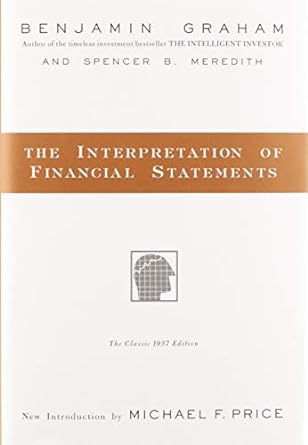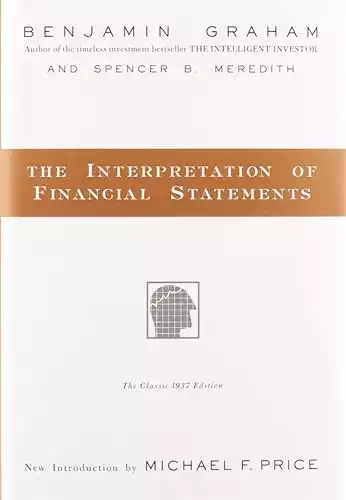Overview : The Interpretation of Financial Statements
- Book Title: The Interpretation of Financial Statements
- Author: Benjamin Graham and Spencer B. Meredith
- Publication Date: 1937
- price: $19.99
- Pages: 120
Overview of the Book
Benjamin Graham, widely regarded as the "Father of Value Investing," was a renowned economist and professional investor. His groundbreaking work in financial analysis and investing principles continues to influence investors worldwide.
Introduction
In the ever-evolving world of finance and investing, some principles remain timeless. "The Interpretation of Financial Statements" by Benjamin Graham and Spencer B. Meredith is a testament to this fact. First published in 1937, this seminal work continues to be a cornerstone for investors, financial analysts, and anyone seeking to decipher the language of financial reports.
Book Summary
Graham, widely regarded as the "father of value investing," and Meredith present a systematic approach to understanding financial statements. The book breaks down complex financial concepts into digestible pieces, making it accessible to both novice investors and seasoned professionals.
Key areas covered include:
- Detailed analysis of balance sheets
- Interpretation of income statements
- Understanding cash flow statements
- Importance of ratio analysis in financial assessment
"The secret to sound investment is a thorough understanding of financial statements." - Benjamin Graham
Analysis of Themes
Demystifying Financial Statements
The authors excel in breaking down the intimidating world of financial reports. They meticulously define essential concepts such as assets, liabilities, equity, revenue, and expenses, building a solid foundation for readers to progress through more complex analyses.
Balance Sheet Breakdown
Graham and Meredith emphasize the balance sheet's importance as a snapshot of a company's financial health. They guide readers through assessing a company's liquidity, solvency, and overall financial stability, providing practical examples that make the concepts more relatable.
Income Statement Insights
The book offers a comprehensive look at income statements, explaining how they provide insights into a company's profitability. Readers learn to interpret key metrics such as gross profit margin and operating margin, crucial for evaluating operational efficiency and profitability.
Cash Flow Analysis
Often overlooked, the cash flow statement receives due attention in this book. The authors underscore its importance in determining a company's ability to sustain operations and grow, teaching readers to analyze cash flow from operating, investing, and financing activities.
Ratio Analysis
Graham and Meredith introduce various financial ratios that can be used to evaluate a company's performance, liquidity, and financial health. This analytical approach empowers readers to make more nuanced assessments of potential investments.
Writing Style
The book's strength lies in its straightforward approach. The authors use clear, concise language to explain complex financial concepts, making the material accessible to readers with varying levels of financial knowledge. Their use of practical examples and analogies helps bridge the gap between theory and real-world application.
Strengths and Weaknesses
Strengths:
- Clear and concise explanations of financial concepts
- Practical examples that illustrate key points
- Timeless principles that remain relevant in modern finance
- Comprehensive coverage of financial statement analysis
Weaknesses:
- Lack of coverage on modern financial instruments and techniques
- Some examples may feel dated to contemporary readers
Comparison to Other Works
While "The Interpretation of Financial Statements" provides a solid foundation, it's worth comparing it to more recent works in the field:
- "Financial Statement Analysis" by Martin Fridson and Fernando Alvarez offers a more contemporary take on the subject, incorporating modern accounting practices.
- "Warren Buffett and the Interpretation of Financial Statements" by Mary Buffett and David Clark builds upon Graham's principles, focusing on Buffett's approach to financial analysis.
However, Graham and Meredith's work remains unique in its clarity and focus on fundamental principles, making it an excellent starting point for those new to financial analysis.
Highlights from The Interpretation of Financial Statements
- Understanding financial statements: Provides a clear guide to reading and interpreting income statements, balance sheets, and cash flow statements.
- Key financial ratios: Emphasizes the importance of liquidity, profitability, and solvency ratios.
- Business performance analysis: Teaches how to assess a company's financial health and performance.
- Financial metrics: Focuses on key metrics like earnings per share (EPS) and return on equity (ROE).
- Practical insights: Offers practical tips for investors to make informed decisions based on financial data.
Conclusion
"The Interpretation of Financial Statements" is an indispensable resource for anyone looking to enhance their financial literacy and investment acumen. Its enduring relevance in the face of evolving market trends, including the rise of cryptocurrencies and changes in personal finance, is a testament to the solid foundation it provides.
For investors navigating today's complex financial landscapes, from traditional markets to emerging sectors, the principles outlined in this book offer a timeless framework for analysis and decision-making. Whether you're interested in value investing, tracking market trends, or simply want to better understand your personal finances, this book provides the tools to interpret financial data with confidence.
In an era where financial information is abundant but understanding is scarce, Graham and Meredith's work remains a beacon of clarity and wisdom. It's not just about reading numbers; it's about comprehending the story behind those numbers and using that knowledge to make informed financial decisions.





